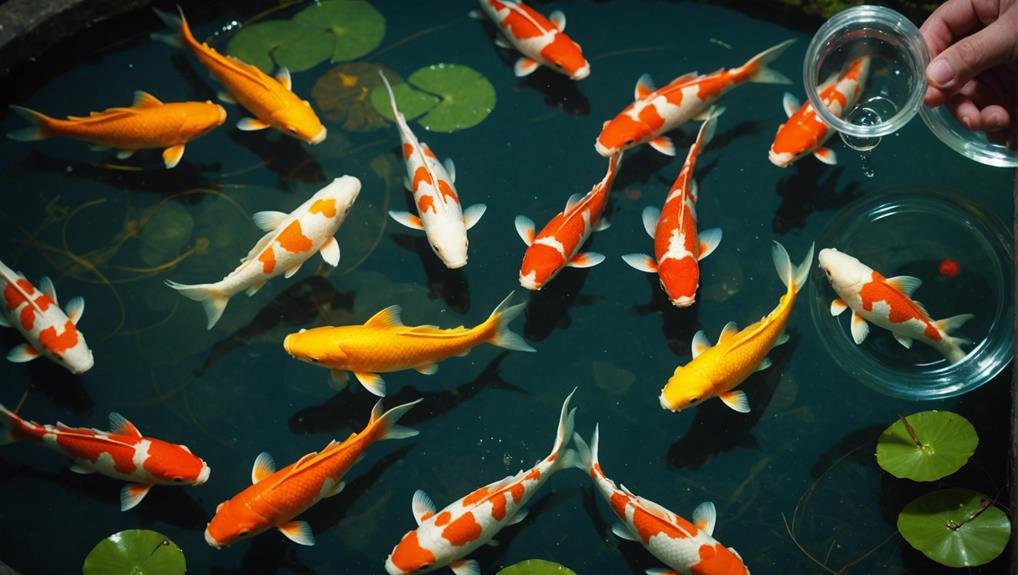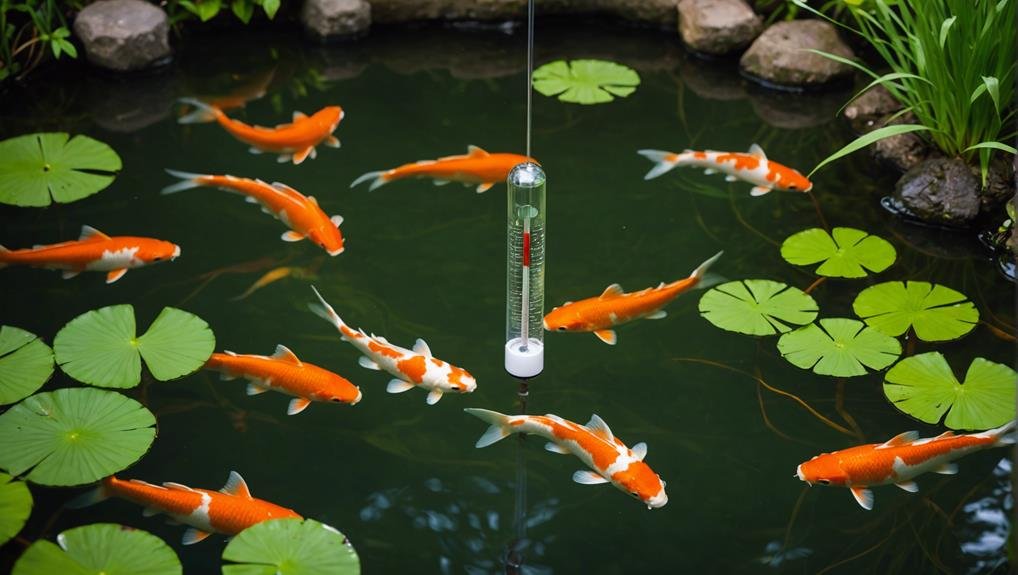Regular water testing for koi ponds is crucial to ensure the health and well-being of our beloved fish. Maintaining the pH levels within the range of 7.2-8.5 is vital to prevent stress on the koi.
High levels of ammonia can hinder oxygen absorption, so it's important to keep a close eye on this and promptly address any spikes with water changes and beneficial bacteria. To prevent harm, nitrate levels should be kept below 20 mg/l, which can be managed through regular water changes.
Dissolved oxygen levels should always be above 5 mg/L, and using proper aeration methods can help achieve this. Additionally, maintaining a water temperature between 59-77°F is essential to prevent unnecessary stress on the koi.
By monitoring these factors closely and taking appropriate actions, we can create a healthy and thriving environment for our koi.
Monitoring Ph Levels
Maintaining the pH levels in a koi pond is crucial for the well-being of our fish. The optimal pH range for a koi pond falls between 7.2 and 8.5, ensuring a healthy environment and water quality for our aquatic friends.
When pH levels deviate from this range, it can stress the fish and make them susceptible to diseases or even death.
High acidity in the pond can disrupt filter function and harm the fish. Regular monitoring and adjustments are necessary to address this issue.
Conversely, if the water becomes too alkaline, corrective measures such as water changes or the addition of substances like peat moss may be required to lower the pH levels. It's essential to conduct frequent pH tests to maintain a balanced environment for the koi.
By actively monitoring and managing the pH levels in our koi pond, we can create a safe and thriving habitat for our fish.
Assessing Ammonia Concentrations
Monitoring ammonia levels in our koi pond is crucial for maintaining the health and well-being of our fish. Ammonia, a harmful chemical present in fish waste, can hinder their oxygen absorption, leading to stress and potential health issues. To ensure a healthy environment for our fish, it's essential to regularly assess and manage ammonia levels.
When faced with elevated ammonia levels, it's recommended to immediately conduct a 20% water change. This simple step can help reduce the concentration of ammonia in the water, minimizing its toxic effects on the koi. Additionally, introducing products containing beneficial bacteria can aid in the breakdown of ammonia, promoting a cleaner and safer environment for our fish.
In cases where immediate action is needed, products like ammolock can be utilized to temporarily bind ammonia, providing a short-term solution while addressing the root cause of the issue. By consistently monitoring and addressing fluctuations in ammonia levels, we can prevent spikes that may result from factors such as overfeeding, insufficient filtration, or a lack of beneficial bacteria.
Regular testing, prompt water changes, and the use of appropriate products are key in maintaining a balanced ecosystem in our koi pond. By staying vigilant and proactive in our approach to managing ammonia levels, we can ensure the continued health and vitality of our fish.
Measuring Nitrate Levels

To maintain a healthy koi pond, it's crucial to monitor and manage nitrate levels regularly. Nitrate is a byproduct of the nitrogen cycle and can become harmful to fish if it accumulates. Keeping nitrate levels below 20 mg/l is ideal for ensuring excellent water quality and preventing issues like algae overgrowth, which can harm the pond's ecosystem.
One effective way to control nitrate levels is through regular water changes. By replacing some of the pond water with fresh water, the concentration of nitrates can be diluted, reducing the risks to our koi.
It's also essential to monitor nitrate levels using a reliable water test kit. This allows us to take corrective measures promptly if levels are too high, ensuring a safe environment for our fish.
It's worth noting that while ammonia and nitrite are more immediately toxic, high nitrate levels can still have long-term health consequences for koi. By staying vigilant and addressing nitrate levels proactively, we can maintain a healthier and more balanced pond environment for our beloved fish.
Evaluating Dissolved Oxygen
Maintaining adequate levels of dissolved oxygen is crucial for the well-being of our koi fish. To ensure that our koi thrive, it's essential to keep the dissolved oxygen levels in the pond above 5 mg/L. Low oxygen levels can result in fish stress, stunted growth, and increased susceptibility to diseases. Therefore, it's important to focus on proper aeration to maintain good water quality.
During the hot summer months, it's especially important to monitor the dissolved oxygen levels as they can decrease during this time. There are various methods we can use to ensure that our koi pond has enough dissolved oxygen. Aeration systems such as air stones, waterfalls, and fountains can help increase oxygen levels by introducing air into the water. Regular maintenance, including cleaning filters and removing debris, is also crucial to prevent clogging and maintain efficient water circulation.
Observing the activity of the fish can also provide valuable insights into the water quality. Active and healthy fish indicate good oxygen levels, while sluggish behavior may signal low oxygen levels.
By ensuring sufficient aeration, we support the growth of aerobic bacteria, which play a key role in maintaining water clarity and overall pond water quality.
Regular monitoring of dissolved oxygen levels and making adjustments to our aeration systems as needed will help create a thriving environment for our koi fish. By taking these steps, we can prevent fish stress and promote the health and well-being of our beloved koi.
Checking Water Temperature

Maintaining the right water temperature in our koi pond is crucial for the health and well-being of our fish. Koi fish prefer water temperatures between 59-77°F to thrive. Keeping our pond water within this range consistently is key to ensuring our koi remain healthy and active. Fluctuations in water temperature can stress our koi, weaken their immune system, and make them more vulnerable to diseases.
To monitor the water temperature effectively, it's essential to use a pond thermometer. Regularly checking the temperature can help prevent extreme fluctuations that can harm our koi. Temperatures below 50°F or above 86°F pose significant risks, potentially leading to severe health issues or even death. Maintaining a stable water temperature provides a steady environment for our koi to thrive.
Aside from using a thermometer, we can also consider using pond heaters or shade structures to help regulate the temperature. Consistent monitoring and prompt adjustments play a vital role in ensuring that our koi pond remains a safe and healthy habitat for our fish.
Conclusion
In caring for a koi pond, it's essential to regularly test and monitor key water parameters like pH levels, ammonia, nitrate, dissolved oxygen, and water temperature. These factors are crucial for maintaining a healthy ecosystem for our koi fish.
By staying attentive to these aspects, we can ensure a thriving environment for our beloved fish. Just like a keen gardener who spots weeds early on to prevent them from taking over the garden, regular testing allows us to catch any issues before they escalate.
Let's remain proactive and vigilant in our care for our koi pond to keep our fish happy and healthy.

